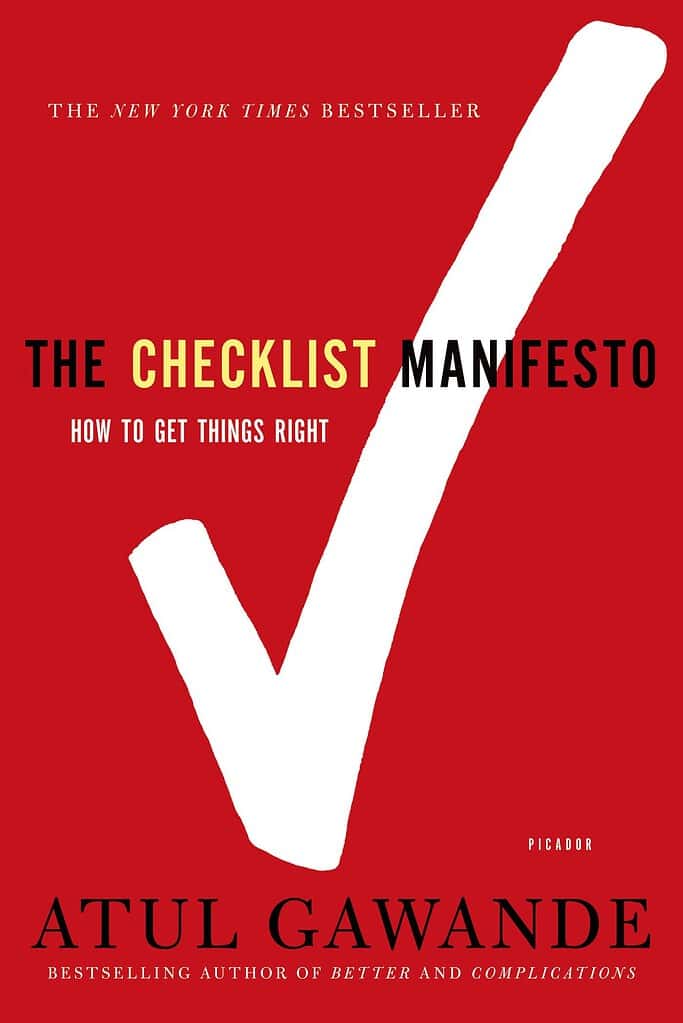The Checklist Manifesto by Atul Gawande | Summary
In today’s fast-paced world, having a system or process in place is crucial for success. As small business owners and high performers, we constantly juggle multiple tasks and responsibilities while trying to stay on top of our game.
However, with so much going on, it’s easy to overlook details or miss the stupid but critical stuff that can greatly impact our results. This is where Atul Gawande’s The Checklist Manifesto comes in—a book that highlights the power of checklists in simplifying complex tasks and improving overall performance.
In this blog post, we will summarize and delve into the key takeaways from this insightful book and how it can help you streamline your workflow and achieve greater success in your personal and professional life. So, let’s discover the magic of checklists!
Gawande describes his story of using a checklist created to improve the medical field. He helped the World Health Organization implement a safe surgery checklist to reduce global complications and deaths from surgical operations. Gawande also examines the role of checklists in the aviation and construction industry and presents the case for their implementation in other sectors.
The Problem Of Extreme Complexity In An Increasingly Complex World
In 1928, Alexander Fleming discovered Penicillin. This healthcare innovation seemed like a simple treatment to cure many illnesses or injuries. Penicillin was effective against several once-untreatable infections. However, the medical realm did not become simpler.
The past century has had many amazing discoveries that have led to more specialization in health care. Most diseases require more specific and intricate treatments, even those once simply treated with penicillin.
Nowadays, treatments vary depending on multiple therapies, the patient’s condition, and the organ systems affected. Thus, medicine has become highly complex and difficult for humans to master.
In the ninth edition of the World Health Organization’s international classification of diseases, there are now more than 13,000 different diseases, syndromes, and injuries. For most of them, science has found treatments to heal the body. If a cure does not exist, then there is a way to mitigate the damage and impact on the body. However, doctors must choose between 6,000 drugs and 4,000 procedures with different specifications, risks, and considerations for any situation.
This complexity has pushed individuals in the medical field to specialize more and more with many years of training. One needs to have an undergraduate degree, a medical degree, and years of residency training.
However, there is still an unacceptably large amount of avoidable failures. In the Checklist Manifesto, Gawande asks the question, “What do you do when expertise is not enough?” Complex procedures require objective analysis, delegation, and the use of checklists to ensure essential steps are not overlooked.
The Checklist
In 1935, the US Army Air Corps held a flight competition to win a contract for a new long-range bomber. The Boeing aircraft seemed superior, with a larger payload, faster speed, and longer range. In flight, the Boeing aircraft crashed due to “pilot error” and was deemed too complicated to fly. In response, a few test pilots created a simple checklist for pilots to use at critical stages in flight. The Army ordered almost 13,000 B-17 aircraft, which, utilizing a checklist, have flown over a million miles with no incident.
Similarly, significant parts of software engineering, finance, law enforcement, legal work, and medicine have become too complicated. Thus, using a checklist can alleviate complexity. In medicine, doctors use a simple check of four vital signs (body temperature, pulse, blood pressure, and respiratory rate), which give workers a good indication of how sick a person is. This demonstrates how checklists function as quick and simple tools to support expert professionals in complex environments.
Human Nature In Complexity
The Checklist Manifesto discusses two main issues that experts face in a complex environment:
- Humans are fallible when it comes to memory and attention. These tendencies are very problematic when skipping one step in all-or-nothing processes, such as baking a cake, landing an airplane takeoff, or evaluating a sick patient.
- Humans can skip steps that seem not to matter. One day, a routine-specific action in a complex process may be the difference between success and failure.
Checklists help us prevent catastrophic failure in a complex world. They provide us with the minimum viable process and make the steps clear. They also allow us to verify our habits and actions and raise our performance level.
The End Of The Master Builder
Checklists have limits, so it is essential to determine when they are suitable. In complex lines of work, such as modern construction projects, checklists serve as quick and simple tools to support the skills of expert professionals.
Three Types Of Problems
Two professors, Zimmerman and Glouberman, studied the science of complexity and have categorized problems as follows:
- Simple: These issues are like following a recipe. There may be a few basic techniques to learn; however, once the formula is discovered, it will result in a high probability of success.
- Complicated: These problems are repeatable, such as sending a rocket to the moon. They can be differentiated into a series of simple issues. Success relies on several people and teams with expertise.
- Complex: These problems are difficult ones, such as raising a child. Each is unique with children, provides experience, and may require a different approach to success in complex processes.
Gawande looked to the construction industry for the value of checklists. For most of history, the responsibility of constructing a large building was in the hands of a single Master Builder. They would design, engineer, and manage the entire construction from beginning to end. By the mid-twentieth century, construction became much more complicated, Master Builders disappeared, and specialization occurred, similar to the medical world. The construction industry had to adapt because building failure was not an option, as many lives were on the line.
However, hospitals still rely on a leader or “a lone Master Physician with a prescription pad, an operating room, and a few people to follow his lead, plan, and execute the entirety of care for a patient, from diagnosis through treatment.”
In construction projects, workers use various checklists and schedules to overcome complexity. These checklists enable tracking progress and prompting communication between several workers. The result is that failure has become very rare, with an average of 20 serious “building failures” per year or 0.00002 percent. In the Checklist Manifest, Gawande states that “the checklists work.”
The Idea
In the construction industry, there is a two-checklist approach to dealing with the complexity:
- What: The first checklist detailed the tasks that had to be done and relied on central control from management. These lists ensure that your people don’t overlook the routine, critical aspects.
- How: The second checklist described how to deal with challenging and unforeseen circumstances for workers. These lists ensure communication to deal with issues democratically and measure progress toward project objectives.
This Checklist Manifesto principle forces the decision-making away from management and to the lowest levels. Your people are empowered and are responsible for making decisions and adapting situations based on individual expertise and experience. If you make decisions from the top down or micromanage, then you will fail in complicated circumstances. If your people fail to communicate with one another, then the isolation will also result in failure.
When people make decisions, there must be a balance of freedom and expectation, technique and procedure, and specialization and collaboration. This knowledge is captured in the two opposing types of checklists above, including the do-confirm checklist. The lists help in any complicated situation, field, or profession, even the medical field.
The First Try
In 2006, the World Health Organization reached out to Gawande, as he was an expert on patient safety in surgery. The number of surgical operations had escalated worldwide to 230 million per year in 2004, with complications becoming a public danger at an estimated 3 to 17 percent. Thus, the WHO wanted him to lead a team to decrease avoidable deaths and harm from surgery globally.
In 2007, the WHO held a conference for doctors, nurses, and other experts from many backgrounds to determine how to solve the surgery issue. The participants discussed various solutions, including offering incentive pay for practitioners publishing surgical care guidelines. However, Gawande examines his search in the Checklist Manifesto for a more simpler solution, such as using vaccines to eliminate diseases or soap to improve public health. He thought that checklists could be the answer.
After examining the uses of the checklist from three hospitals (Toronto, Hopkins, and Kaiser) for specific issues, Gawande found a theme of fostering teamwork. He
The Checklist Factory
After the first attempt, Gawande went to Daniel Boorman at Boeing to learn about how they wrote a new checklist for aircraft.
Good Vs. Bad Checklists
Boorman explained that Checklists could be either good or bad:
- Bad: These checklists are vague, lengthy, and impractical. They have been written by desk workers who have yet to work in relevant situations. The lists treat workers as stupid, are overly prescriptive, and inhibit critical thinking.
- Good: These checklists are precise, efficient, concise, practical, and wide-ranging. They have been written by practitioners who have experience and expertise. The lists reiterate the most critical steps, clarify priorities, and foster communication. They are not intended to be comprehensive how-to guides but rather quick tools to support skilled professionals.
Two Types Of Decision Points
However, checklists still have limitations, as it is tough to make people follow them. Checklists must include key decision points, in which you have to pause to use the list. You must decide between using the following types per the situation:
- Do-Confirm Checklist: “The team members perform their jobs from human memory and experience, often separately.” With each pause point, they use the checklist to confirm everything that must have been done.
- Read-Do Checklist: The team uses the checklist to conduct tasks and check them off one by one, like a recipe. These checklists serve as simple tools aimed at buttressing the skills of expert professionals in complex lines of work.
Checklist Rules Of Thumb
Here are the Checklist Manifesto rules of thumb for creating a Checklist:
- Restrict to five to nine items, which is the limit of working memory.
- Keep the wording simple, precise, and within the professional or familiar language.
- Fit the contents to one page, remove clutter, and eliminate unnecessary colors.
- Use both uppercase and lowercase text with a Sans Serif font for easy reading.
In complicated professions, checklists should not be detailed how-to guides but rather a simple tool to supplement your work.
The Test
There seemed to be some hope, so Gawande tried to incorporate aviation lessons to make the surgery checklist useful. After deliberation and testing, the team finalized a 19-item surgery checklist for the WHO with three pause points:
- Five checks before anesthesia,
- Seven checks after anesthesia and before incision, and
- Five checks before the patient leaves the operating room.
In 2008, eight hospitals from eight different countries tested the safe surgery checklist. “Using the checklist involved a major cultural change, as well—a shift in authority, responsibility, and expectations about care—and the hospitals needed to recognize that.” And it followed that many hesitated to use the checklist or threw the observers out of the operating room. However, Gawande found several stories encouraging during testing that are elaborated upon in the Checklist Manifesto.
The final results were better than he expected as the quick and simple tools reduced the rate of major surgery-related complications by 36 percent and death by 47 percent. Also, the study found that the list fostered communication, leading to fewer errors. In 2009, the New England Journal of Medicine published the results, and the interest in the global implementation of the checklist started to grow. Lastly, the study asked the hospital staff whether they would want to use a checklist, and 93 percent said yes.
The Hero In The Age Of Checklists
In any effort, there is an opportunity to determine the patterns of such failures and establish a checklist as a safety net to prevent them from occurring. However, it has yet to become mainstream, especially in medicine.
Gawande discussed that only 12 countries have publically pledged to implement safe surgery checklists in their hospitals. By late 2009, about 10 percent of US hospitals and 2000 other international hospitals had implemented them. There was also an untapped opportunity to further improve the checklist for surgery and adapt it to other specialized medical procedures.
In the 1950s, being a test pilot was heroic but dangerous, as there was a 25 percent chance of dying on the job. Over time, good checklists and flight simulators helped manage the risks of flying, and pilots lost their hero status. Gawande believes that something similar is happening in medicine to make medical professionals more effective.
Despite the developments that checklists bring, there is still a need for heroic attributes of courage, intelligence, and improvisation. In early 2019, a US flight experienced a bird strike shortly after takeoff, which caused the engines to fail. Known as the “miracle on the Hudson,” Captain Sully and his crew landed the plane safely in the Hudson River, and everyone on board survived. The heroic team remained calm, worked together, followed critical procedures, and improvised when necessary in challenging circumstances.
Interestingly, the same principles of checklists and structured routines seen in aviation and medicine are echoed in the advice given in many time management books. By breaking down tasks, creating pre-flight routines, and anticipating potential obstacles, individuals can streamline their workflows and achieve more within their personal and professional lives.
Professional Expectations
The crew was disciplined, but this expectation is missing from most professions. In learned professions, the Checklist Manifesto states that there is a code of conduct with three significant expectations:
- Selflessness: We, who accept responsibility for others, will place the needs and concerns of those who depend on us above our own.
- Skill: We will aim for excellence in our experience and expertise.
- Trustworthiness: We will be responsible for our behavior toward our charges.
In aviation, there is a fourth expectation of discipline: following sound procedures and working well with others. Most professions, especially medicine, value autonomy over discipline; however, we should value discipline in our new world of complexity, high-risk, and large enterprises.
In an increasingly complex world, humans are not naturally inclined to discipline, which is why aviation has incorporated checklists to instill discipline. Over time, these checklists have been adapted through safety assessments and aircraft innovation. In other highly complex fields, we have no choice but to try checklists.
The Save
Gawande discusses how the checklists have impacted his own surgical operations. In 2007, he started using the safe surgery checklists. He was amazed at how the checklist helped his team catch mistakes or omissions.
Gawande concludes the Checklist Manifesto with the story of how he saved his patient’s life. During a surgical operation, he accidentally created a hole in a major artery, and the patient was losing blood fast. The checklist helped a nurse have sufficient blood to deal with emergencies.
The checklist also fostered communication and teamwork; it took the whole team to work calmly to save the patient. In the end, the patient survived, was grateful, and was happy for the story to be included in the book. This personal journey and the lessons learned are well captured in the checklist manifesto summary.
Final Thoughts on “The Checklist Manifesto” Summary
The Checklist Manifesto is a thought-provoking and eye-opening book that emphasizes the importance of checklists in our daily lives.
We have learned that despite our expertise or experience, we are all susceptible to human error and can benefit from using checklists to ensure consistency and accuracy. From the aviation industry to surgical procedures, checklists have proven to be powerful tools for success.
So why not implement them in our own lives? Let’s take a moment to reflect on this question: How many mistakes could have been avoided if we had just taken a few extra minutes to go through a simple checklist?
With this in mind, I urge you to read the Checklist Manifesto and see for yourself the impact checklists can have on personal and professional endeavors. Read the Checklist Manifesto and start implementing checklists in your routine!








